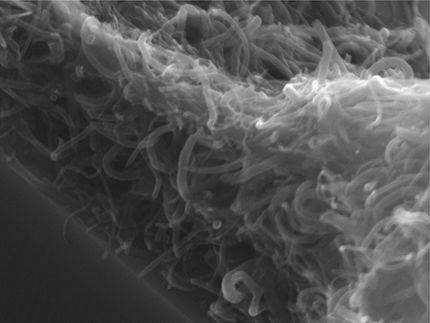Stretchable electronics that quadruple in length
Conductive tracks are usually hard printed on a board. But those recently developed at EPFL are altogether different: they are almost as flexible as rubber and can be stretched up to four times their original length and in all directions. And they can be stretched a million times without cracking or interrupting their conductivity. The invention is described in an article published today in the journal Advanced Materials.
Both solid and flexible, this new metallic and partially liquid film offers a wide range of possible applications. It could be used to make circuits that can be twisted and stretched - ideal for artificial skin on prosthetics or robotic machines. It could also be integrated into fabric and used in connected clothing. And because it follows the shape and movements of the human body, it could be used for sensors designed to monitor particular biological functions.
"We can come up with all sorts of uses, in forms that are complex, moving or that change over time," said Hadrien Michaud, a PhD student at the Laboratory for Soft Bioelectronic Interfaces (LSBI) and one of the study authors.
Extensive research has gone into developing an elastic electronic circuit. It is a real challenge, as the components traditionally used to make circuits are rigid. Applying liquid metal to a thin film in polymer supports with elastic properties naturally seems like a promising approach.
Thin and reliable
Owing to the high surface tension of some of these liquid metals, experiments conducted so far have only produced relatively thick structures. "Using the deposition and structuring methods that we developed, it's possible to make tracks that are very narrow - several hundredths of a nanometer thick - and very reliable," said Stéphanie Lacour, who runs the lab.
Apart from their unique fabrication technique, the researchers' secret lies in the choice of ingredients, an alloy of gold and gallium. "Not only does gallium possess good electrical properties, but it also has a low melting point, around 30o," said Arthur Hirsch, a PhD student at LSBI and co-author of the study. "So it melts in your hand, and, thanks to the process known as supercooling, it remains liquid at room temperature, even lower." The layer of gold ensures the gallium remains homogeneous, preventing it from separating into droplets when it comes into contact with the polymer, which would ruin its conductivity.
Most read news
Topics
Organizations
Other news from the department science

Get the chemical industry in your inbox
From now on, don't miss a thing: Our newsletter for the chemical industry, analytics, lab technology and process engineering brings you up to date every Tuesday and Thursday. The latest industry news, product highlights and innovations - compact and easy to understand in your inbox. Researched by us so you don't have to.
Most read news
More news from our other portals
See the theme worlds for related content
Topic world Sensor technology
Sensor technology has revolutionized the chemical industry by providing accurate, timely and reliable data across a wide range of processes. From monitoring critical parameters in production lines to early detection of potential malfunctions or hazards, sensors are the silent sentinels that ensure quality, efficiency and safety.

Topic world Sensor technology
Sensor technology has revolutionized the chemical industry by providing accurate, timely and reliable data across a wide range of processes. From monitoring critical parameters in production lines to early detection of potential malfunctions or hazards, sensors are the silent sentinels that ensure quality, efficiency and safety.




























































